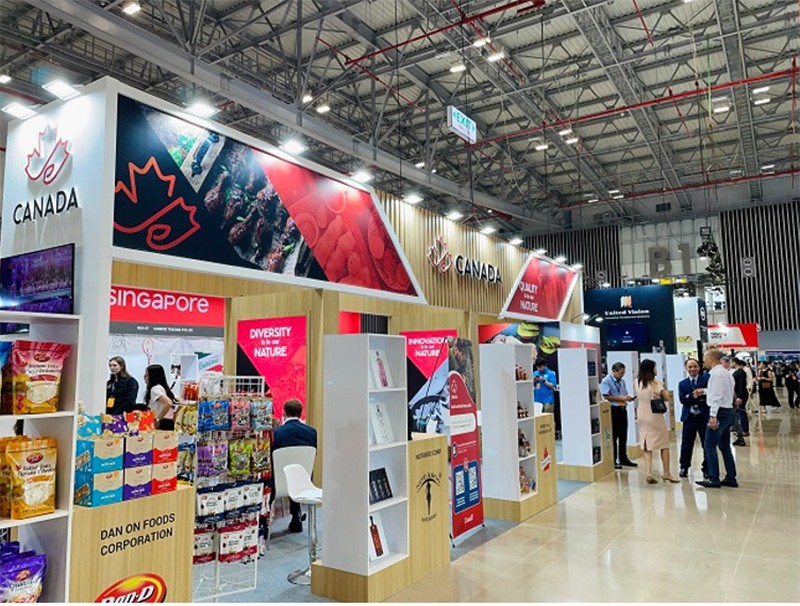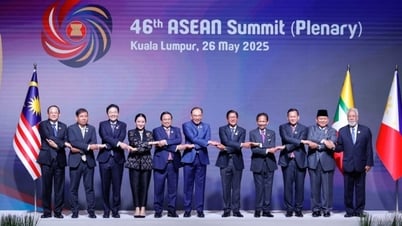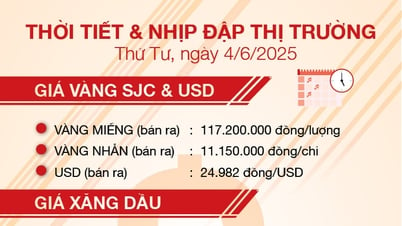Canadian businesses will look to new manufacturing locations and Vietnam as a hub to manufacture and export to Indonesia or the Philippines or other countries.
 |
| Canadian business booth participating in Food Hotel Vietnam 2022 exhibition. (Photo: Hai Uyen) |
In its strategy of seeking markets outside the United States, Canada has chosen agricultural products and processed foods to expand exports to the Indo-Pacific region, while promoting production and trade activities in this region.
The above strategy is currently being focused on by Export Development Canada (EDC) in Southeast Asia, especially in a number of countries that have bilateral and multilateral free trade agreements with Canada.
In this strategy, Vietnam has emerged as a notable destination as it is seen by Canadian businesses as a gateway to the Association of Southeast Asian Nations (ASEAN) and the Asia- Pacific region .
Vietnam is also among several ASEAN countries that have signed the Comprehensive and Progressive Agreement for Trans -Pacific Partnership (CPTPP) with Canada. In particular, Vietnam is being considered as a place that can receive investment in production for further export to other Canadian markets.
Canada is well-positioned to compete anywhere in wheat, beans, grains and barley, and its seafood, such as crab, lobster and salmon, is among the best in the world and highly competitive in quality, said Ashley Kanary, director of agri-food at EDC.
Mr. Kanary believes that with the above strengths, Canada sees itself having many opportunities everywhere. In addition to the issue of quality, this country also has a high reputation in ensuring food security, which is also an advantage.
The focus on connecting agricultural and processed food production between Canada and Vietnam is expected to create great opportunities for both economies, including in the fields of trade and food security.
Commercial Counselor of the Vietnamese Embassy in Canada Tran Thu Quynh shared that agricultural products of Vietnam and Canada are mutually supportive, not competitive, because they share many free trade agreements with other countries, especially the CPTPP Agreement between the two countries.
Ms. Tran Thu Quynh said that this is an opportunity for businesses of the two countries to jointly exploit the principle of cumulative origin, bringing it into agricultural processing production to increase the added value of Vietnam's current purely agricultural products.
The Vietnam Trade Office in Canada regularly shares with you information about opportunities in the Vietnamese market and introduces Vietnam as a gateway for Canada to enter the ASEAN and Asia-Pacific regions.
In fact, Vietnam is making great efforts to invest in infrastructure such as seaports, roads and telecommunications technology. These are activities that create good gateways for Canadian businesses to invest in Vietnam and use Vietnam as an export destination to countries in the region or vice versa.
We will see an increase in Canadian companies coming to Vietnam and using it as a manufacturing hub and possibly a processing hub in the agri-food sector, said Nathan Adrew Nelson, director of Indo-Pacific innovation and head of Vietnam at EDC.
According to Nelson, Canadian companies have been shifting production overseas, such as to China, where they can take advantage of lower costs, and then re-exporting to North America and Europe. Now, they will look for new production locations and use Vietnam as a hub to produce and export to Indonesia or the Philippines or other countries.
Vietnam is considered a place with many investment opportunities and is a rising star in Canada's strategy to expand its market to the Indo-Pacific region. This can be understood that Vietnam is being calculated as a place that can replace China and become a manufacturing and export center for Canada and developed countries in the future.
Source: https://baoquocte.vn/viet-nam-la-cua-ngo-de-doanh-nghiep-canada-chinh-phuc-thi-truong-chau-a-thai-binh-duong-299683.html


































































































Comment (0)